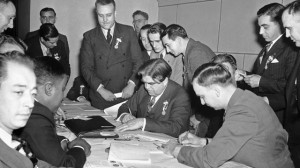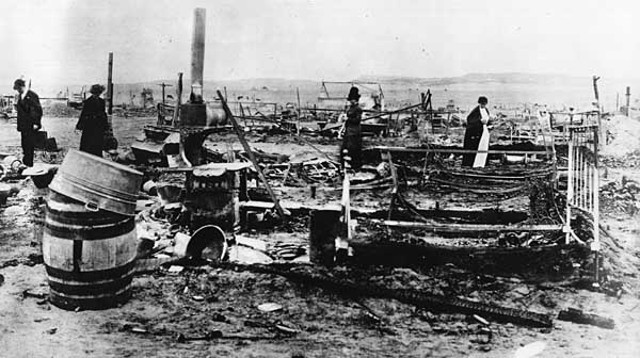Editor’s note: Sunday marked the 100th anniversary of the Ludlow Massacre. For more information about this landmark event in US labor history, visit PBS’ “American Experience.”
On April 20, 1914, the Colorado National Guard and a private militia employed by the Colorado Fuel & Iron Company (CF&I) opened fire on a tent camp of striking coal miners at Ludlow, Colo. At least 19 people died in the camp that day, mostly women and children.
A century later, the bloody incident might seem a relic of the distant past, but the Ludlow Massacre retains a powerful, disturbing and growing relevance to the present. After a century of struggling against powerful interests to make American workplaces safer and corporations responsive to their employees, the US is rapidly returning to the conditions of rampant exploitation that contributed to Ludlow.
A century ago, miners led the fight for workers’ rights. The Gilded Age of the late 19th and early 20th centuries was a period of great upheaval for the American working class. For decades, the United Mine Workers of America (UMWA) had worked to organize the nation’s coal miners. Its success often hinged on whether the government helped mining companies crush strikes or protected workers. In 1897, deputies in Luzerne County, Pa., killed 19 striking miners in the Lattimer Massacre. But five years later, when Pennsylvania miners struck again, President Theodore Roosevelt intervened on their behalf, providing them with a partial victory. Roosevelt’s actions, while hardly indicative a new pro-labor federal government, reflected a growing belief that labor deserved a fair shake.

John D. Rockefeller Jr., and his father John D. Rockefeller in 1915. (American Press Association, Library of Congress)
Colorado Fuel and Iron, part of John D. Rockefeller’s empire, was the largest coal company in the American West. Colorado had laws regulating mine safety, but CF&I ensured they remained unenforced. Workers weren’t paid for time spent traveling into or out of the mines, shoring up mine ceilings or fixing tools. CF&I brought in a polyglot group of laborers to these remote southern Colorado mines — Mexicans, Italians and Greeks dominated. They lived in company towns under the control and watchful eye of CF&I bosses.
Conditions were deadly inside the mines. Flooded mines forced workers to toil in standing water. Hazardous gases filled the cramped spaces, and miners constantly inhaled bad air. They relied on animals to warn them when the gases turned deadly. Explosions were frequent, and carbon monoxide seeping through mines felled workers after the blasts. Coal dust coated miners’ lungs and gave them what is today known as pneumoconiosis, or black lung disease. All of these problems made for short, danger-filled lives. In 1909, 259 coal miners died at the Cherry Mine Fire in Illinois.
Colorado coal miners first struck in 1894, led by the UMWA. Over the next 20 years, workers fought often bloody battles for better pay and working conditions. In 1913, the miners demanded an eight-hour day, the right to choose their own homes and doctors, a pay raise, and the enforcement of existing mine safety laws. The union presented these and other demands to CF&I. The company rejected them out of hand and the miners went on strike.
But by the spring, the state had run out of money to fund the National Guard’s presence. So, leaving two Guard units in Ludlow as support, Colorado pulled out but gave CF&I permission to fund its own security forces.
On the morning of April 20, the Monday after Easter, the security forces lured strike leader Louis Tikas out of camp. One of the Guard commanders, Karl Linderfelt, promptly broke a rifle butt on Tikas’ head, then the Guardsmen shot him in the back, killing him. The CF&I militia opened fire on the camp, sparking a day-long battle. Finally, the militia set the camp on fire, killing 15 women and children hiding in cellars built for protection against gunfire. It was the death of these 15 innocents that led to the term, “Ludlow Massacre.”
The strikers didn’t meekly return to work. A 10-day guerilla war ensued, resulting in 75 to 100 deaths. Strikers destroyed mine buildings and tunnels and blew up the dam providing water for the Ludlow mines. Finally, President Woodrow Wilson sent in the US Army to end the hostilities. Unlike previous examples of federal intervention in strikes, Wilson ordered that the Army remain neutral, and soldiers arrested several members of the company’s private militia. Nevertheless, by December, the UMWA had run out of funds and the strike ended in a total defeat.
The Ludlow Massacre was a public relations disaster for Rockefeller. He was vilified in the press for the killing of women and children. The US Commission on Industrial Relations savaged the mining company in their report on the massacre, calling Rockefeller’s representative in Colorado, L.M. Bowers, “bitter and prejudiced in the extreme, with an adherence to the individualistic economic doctrines of a century ago that was almost grotesque in its intensity.”
To limit the public relations damage, Rockefeller created a company union that allowed workers to present their grievances to management, but it was a sham; the workers had no power in the bogus union.

John L. Lewis, chairman of the Congress of Industrial Organizations signs autographs just like any movie star for his admirers at the CIO Convention in Pittsburgh, Nov. 16, 1938. (AP Photo)
But Ludlow and other acts of violence against labor unions helped convince Americans of the need for real reform. Over the next several decades, conditions for all American workers improved dramatically. United Mine Workers president John L. Lewis created the Congress of Industrial Organizations (CIO) in the 1930s, leading to the unionization of millions of industrial workers. New Deal legislation forced companies to negotiate with their workers in good faith. In the 1960s, rank and file mineworkers, angry over the continued lack of safety in the mines, organized to protest their working conditions. This led to the Federal Coal Mine Health and Safety Act of 1969, one of the most important pieces of worker safety legislation in American history.
In recent years, American mining companies have undermined the effectiveness of many of these reforms. West Virginia mandates that the state legislature must approve all environmental regulations, making meaningful regulation all but impossible. The companies managed to influence the scientific testing of black lung claims. Miners suffering from black lung need to have their cases confirmed by doctors, but a single pro-coal scientist at Johns Hopkins University denied all 1,500 cases he saw between 2000 and 2013. After the Center for Public Integrity exposed this travesty — winning a Pulitzer Prize in the process — Johns Hopkins suspended its black lung testing program.
In 2010, 29 miners died at the Upper Big Branch mine in West Virginia, the nation’s deadliest mine explosion since 1970. Don Blakenship, CEO of the mine’s owner, Massey Energy, had long fought against safety and environmental regulations. The mine’s operation was officially and notoriously unsafe, having racked up over 500 safety violations in the year before the explosion. After the disaster, Massey denied time off for miners to go to their friends’ funerals. Blankenship called the explosion an “act of God” and denied all responsibility.

Mine helmets and painted crosses sit at the entrance to Massey Energy’s Upper Big Branch coal mine Tuesday, April 5, 2011, in Montcoal, W.Va. (AP Photo/Jeff Gentner)
Upper Big Branch was a non-union mine. The coal companies have managed to reduce the UMWA to a shell of its former strength by closing union mines while investing in new non-union mines in the West, and automating jobs that allow them to lay off union members. And when workers lack a voice to fight for their own safety, the results can be disastrous. The UMWA only has 75,000 members today, down from 500,000 in 1946 and 240,000 in 1998. In 2006, an explosion at the non-union Sago Mine in West Virginia killed 13 miners, but the mine was only fined $71,800 for safety violations. Robert Murray, owner of the non-union Crandall Canyon Mine in Utah blew off the safety violations his operation received in 2006 as trivialities. The next year a mine collapse killed six miners and, later, three rescue workers searching for their bodies. When the UMWA criticized Murray’s safety record, he told family members of the dead, “the union is your enemy.” The coal industry is now fighting to reduce the already limited inspections of its mines.
The UMWA struggles to keep up its fight against black lung disease. The number of miners afflicted with the illness has risen in recent years, especially among younger miners. Fifty-two percent of the 113,000 mine dust samples turned into government regulators by coal companies since 1987 exceeded federal standards. Seventy-one percent of the miners who died at Upper Big Branch had already developed the lung lesions that are typical of black lung.
Like John D. Rockefeller Jr., a century ago, Blankenship, Murray and other coal mining CEOs destroy lives and ecosystems without consequences.
What is happening to miners is a sign of our declining labor rights more broadly. We’ve entered a New Gilded Age, a period of intense income inequality where capital mobility, corporate control over politics, union busting and degraded environments have lowered American workers’ standard of living.
Ludlow may seem a distant memory, but today the mine companies continue to exploit miners and corporate domination over our lives again threatens our rights.



